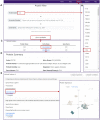SPDB: a comprehensive resource and knowledgebase for proteomic data at the single-cell resolution
- PMID: 37953313
- PMCID: PMC10767837
- DOI: 10.1093/nar/gkad1018
SPDB: a comprehensive resource and knowledgebase for proteomic data at the single-cell resolution
Abstract
The single-cell proteomics enables the direct quantification of protein abundance at the single-cell resolution, providing valuable insights into cellular phenotypes beyond what can be inferred from transcriptome analysis alone. However, insufficient large-scale integrated databases hinder researchers from accessing and exploring single-cell proteomics, impeding the advancement of this field. To fill this deficiency, we present a comprehensive database, namely Single-cell Proteomic DataBase (SPDB, https://scproteomicsdb.com/), for general single-cell proteomic data, including antibody-based or mass spectrometry-based single-cell proteomics. Equipped with standardized data process and a user-friendly web interface, SPDB provides unified data formats for convenient interaction with downstream analysis, and offers not only dataset-level but also protein-level data search and exploration capabilities. To enable detailed exhibition of single-cell proteomic data, SPDB also provides a module for visualizing data from the perspectives of cell metadata or protein features. The current version of SPDB encompasses 133 antibody-based single-cell proteomic datasets involving more than 300 million cells and over 800 marker/surface proteins, and 10 mass spectrometry-based single-cell proteomic datasets involving more than 4000 cells and over 7000 proteins. Overall, SPDB is envisioned to be explored as a useful resource that will facilitate the wider research communities by providing detailed insights into proteomics from the single-cell perspective.
© The Author(s) 2023. Published by Oxford University Press on behalf of Nucleic Acids Research.
Figures




Similar articles
-
[Methods and applications of single-cell proteomics analysis based on mass spectrometry].Se Pu. 2021 Feb;39(2):142-151. doi: 10.3724/SP.J.1123.2020.08030. Se Pu. 2021. PMID: 34227347 Free PMC article. Review. Chinese.
-
COVIDpro: Database for mining protein dysregulation in patients with COVID-19.bioRxiv [Preprint]. 2022 Sep 30:2022.09.27.509819. doi: 10.1101/2022.09.27.509819. bioRxiv. 2022. Update in: J Proteome Res. 2023 Sep 1;22(9):2847-2859. doi: 10.1021/acs.jproteome.3c00092. PMID: 36203550 Free PMC article. Updated. Preprint.
-
An automated proteomic data analysis workflow for mass spectrometry.BMC Bioinformatics. 2009 Oct 8;10 Suppl 11(Suppl 11):S17. doi: 10.1186/1471-2105-10-S11-S17. BMC Bioinformatics. 2009. PMID: 19811682 Free PMC article.
-
SingPro: a knowledge base providing single-cell proteomic data.Nucleic Acids Res. 2024 Jan 5;52(D1):D552-D561. doi: 10.1093/nar/gkad830. Nucleic Acids Res. 2024. PMID: 37819028 Free PMC article.
-
[Recent progress in capillary electrophoresis-based high-sensitivity proteomics].Se Pu. 2020 Oct 8;38(10):1125-1132. doi: 10.3724/SP.J.1123.2020.03003. Se Pu. 2020. PMID: 34213109 Review. Chinese.
Cited by
-
SCPline: An interactive framework for the single-cell proteomics data preprocessing.Brief Bioinform. 2025 May 1;26(3):bbaf256. doi: 10.1093/bib/bbaf256. Brief Bioinform. 2025. PMID: 40462514 Free PMC article.
-
Deciphering breast cancer dynamics: insights from single-cell and spatial profiling in the multi-omics era.Biomark Res. 2024 Sep 18;12(1):107. doi: 10.1186/s40364-024-00654-1. Biomark Res. 2024. PMID: 39294728 Free PMC article. Review.
-
ULV: A robust statistical method for clustered data, with applications to multi-subject, single-cell omics data.ArXiv [Preprint]. 2024 Jun 10:arXiv:2406.06767v1. ArXiv. 2024. PMID: 38947924 Free PMC article. Preprint.
-
Current status and challenges of multi-omics research using animal models of atherosclerosis.J Mol Cell Cardiol Plus. 2025 Jul 10;13:100476. doi: 10.1016/j.jmccpl.2025.100476. eCollection 2025 Sep. J Mol Cell Cardiol Plus. 2025. PMID: 40726539 Free PMC article. Review.
-
The 2024 Nucleic Acids Research database issue and the online molecular biology database collection.Nucleic Acids Res. 2024 Jan 5;52(D1):D1-D9. doi: 10.1093/nar/gkad1173. Nucleic Acids Res. 2024. PMID: 38035367 Free PMC article.
References
MeSH terms
Substances
Grants and funding
LinkOut - more resources
Full Text Sources

